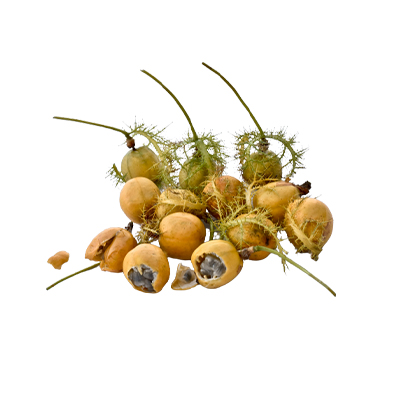Stinking Passion Flower
Passiflora foetida L.
Passifloraceae
Location in our garden
Principal



Synonym
Decaloba obscura (Lindl.) M.Roem.
Dysosmia fluminensis M.Roem.
Dysosmia foetida (L.) M.Roem.
Habitus
Climbers. Annual or perennial fetid scrambling or climbing vine, 1,5 to 5 m long
Part Used
Leaves
Seeds
Fruit
Roots
Stem
Growing Requirements
Need Shade
Habitat
Forest
Coastal
Roadside
Grassland
Overview
The species is native to tropical northern South America and West Indies. It is now naturalised in many tropical areas globally and is deemed a pantropical weed in many countries. While its ripe fruit are edible, its leaves contain cyanic acid and are thought to be poisonous to people and livestock.
Vernacular Names
Long zhu guo (Chinese), Sneekie markoesa (Dutch), Passiflore fétide (French), Übelriechende passionsblume (German), Junuka phul (India), Kusa tokeisou (Japanese), Timun padang (Malaysia).
Agroecology
The species grows wild as woody climbers amongst trees and thickets from sea level to 1,000 m on all soil types – rocky or stony soil, gravelly soil, sand, loam, clay. It prefers wet areas and thrives in disturbed natural vegetation forming a dense ground cover which prevents or delays the establishment of other species.
Morphology
- Stems - hispid, green cylindrical, and has axillary tendrils.
- Leaves - alternate, with three palmate lobes, having acute apices, 2.5–10 cm long by 2.5–10 cm wide.
- Flowers - solitary in axils, 4–5 cm wide white with purple centre, 3 cm across, on pedicels 3–7 cm long. Flowers subtended by prominent involucre of three pale green bracts.
- Fruits - an indehiscent berry or capsule, pale green turning yellow, orange, or reddish when ripe, globular, dry inflated, 2–3 cm across, with thin leathery-skinned, nearly 2 cm thick and enveloped by the shaggy involucral pinnatifid bracts.
- Seeds - numerous, wedge-shaped to ovate, about 4 mm long, with coarse reticulate pattern centrally each side, covered with scanty white, sweet, fragrant, mucilaginous pulp.
Cultivation
- Propagation is both by seed or cuttings.
- Requires a humus-rich, moist but well-drained soil and a position in dappled shade.
- Plants require a temperature no lower than around 16 °C when they are flowering in order to ensure fruit set.
Chemical Constituents
Flavonoids, glycoside, alkaloids, phenolic, steroids, tannins, phytosterol, cyanogenic glycoside, anthraquinones, saponins, cardiac glycosides, passifloricins, α-pyrones and vitexin.
Traditional Medicinal Uses
- Antioxidant, anticancer, hepatoprotective, gastroprotective, antimicrobial/insecticidal, antiulcer, antitumorous activity.
- The fresh, whole plant is boiled and the liquid used as a children's anthelmintic, for intestinal nematodes and flatworms. A decoction of the dried plant is drunk to treat colds and chest coughs.
- The leaves are crushed in water and the solution drunk as an antidote to the bite of the Papuan Black Snake.
- In India, it is traditionally used for the treatment of diarrhoea, throat and ear infections, liver disorders, tumours, itches, fever, skin diseases, and for wound dressing.
- The leaves are applied on the head for giddiness and headache; a decoction is given in biliousness and asthma.
- In Brazil, the herb is used in the form of lotions or poultices for erysipelas, and skin diseases with inflammation.
- In Malaysia, it has been used for treatment of asthma.
- In Vietnam, the leafy shoots and leaves are used for treating neurasthenia, palpitation, insomnia, early menstruation, edema, itching, and coughs.
Part Used
Reference Sources
- Fern, Ken. (2019). Useful Tropical Plants. Passiflora foetida. http://tropical.theferns.info/viewtropical.php?id=Passiflora+foetida. 09-01-2021
- Lim, T. K. (2012). Edible Medicinal And Non-Medicinal Plants: Vol. 4, Fruits. Springer. DOI 10.1007/978-94-007-4053-2_2. (pp.166-173).



